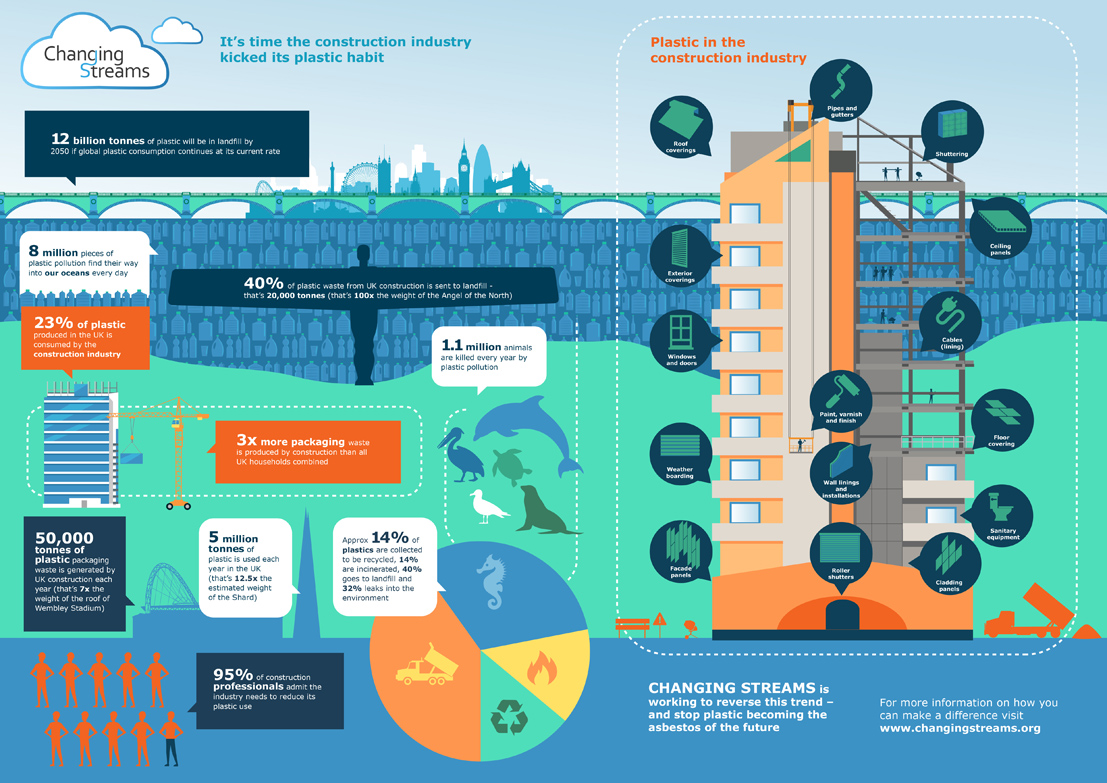
 Changing Streams was established nearly five years ago to address the growing issue of plastic in the construction environment, to work with industry players at all levels to reduce dependence on plastic where possible, minimise waste and identify sustainable alternatives. This is the first in a series of articles to explore the issue and the solutions, and to invite you to join us on our journey.
Changing Streams was established nearly five years ago to address the growing issue of plastic in the construction environment, to work with industry players at all levels to reduce dependence on plastic where possible, minimise waste and identify sustainable alternatives. This is the first in a series of articles to explore the issue and the solutions, and to invite you to join us on our journey.
We all know that plastic waste is a huge problem — we see it every day in our streets, in parks and on the beaches. and every time we come home from grocery shopping there are all those plastic containers and film wraps to deal with. Much publicity has been given to wet wipes blocking sewers with resulting infrastructure damage, and to government initiatives such as banning plastic drinking straws and cotton buds.
Important as all of this is, there is much less publicity given to another major use of plastic — in the construction industry. The sector is second only to packaging in its use of plastic, which has transformed buildings over the last half-century to enable the way we live now. Polymerisation and chemical manipulation have allowed the development of a wide range of materials all coming under the broad heading of plastic — but these may be rigid or pliable, waterproof, and provide electrical or thermal insulation as well as internal structural components and fillers. Textiles from synthetic materials and paints present huge opportunities in design and interior detailing.
However — this comes at a cost to the environment and to the ecosystem that we are a part of. Nearly 10% of fossil fuels extracted are currently used either as raw material or in the production of plastics, a proportion which is likely to increase with the trend to greener energy sources. In a ‘business as usual’ scenario, plastic use in construction is projected to reach 193 million metric tonnes by 2060, which will represent the use of at least twice that amount of fossil fuel.
Emissions, waste and contamination
Why does this matter? Well, firstly in terms of greenhouse gases, plastics already account for approximately 3 to 8% of current global GHG emissions. This number is expected to increase significantly by 2050 if plans to exponentially increase production are realised, with plastics projected to consume 13% or more of Earth’s remaining carbon budget (if we are to keep warming below 1.5˚C).
Secondly, there are major issues in terms of waste and contamination — chemicals as well as polymers, but the need to customise for particular applications has resulted in addition of a huge range of chemicals, which make those polymers functional and attractive. A recent estimate suggested that there may be as many as 16,000 different chemicals used in plastic production, of which are a quarter to give rise to concerns about long-term toxicity.
This diversity of composition means that discarded plastics are very difficult to dispose efficiently, Any skip coming off a construction site will contain plastics of various types from different manufacturers each with an individual chemical footprint. This makes recycling extremely complex and costly, with the result that this waste is more often destined for incineration or landfill. This results in long-term contamination of soil, and potentially of waterways and the air we breathe.
At Changing Streams, we are working with key players in the industry to identify how dependance on plastic construction may be mitigated. In coming issues, we will be inviting you to join us on our journey to reduce unnecessary plastic use and to introduce sustainable alternatives where feasible.
- Global Plastics Outlook: Policy Scenarios to 2060 https://www.oecd-ilibrary.org/sites/aa1edf33-en/1/3/2/2/index.html?itemId=/content/publication/aa1edf33-en&_csp_=ca738cf5d4f327be3b6fec4af9ce5d12&itemIGO=oecd&itemContentType=book
- https://www.statista.com/statistics/282732/global-production-of-plastics-since-1950/#:~:text=The%20worldwide%20production%20of%20plastics,percent%20from%20the%20previous%20year
- https://www.ciel.org/wp-content/uploads/2023/09/Reducing-Plastic-Production-to-Achieve-Climate-Goals_Sept21_V5.pdf









